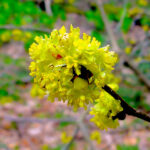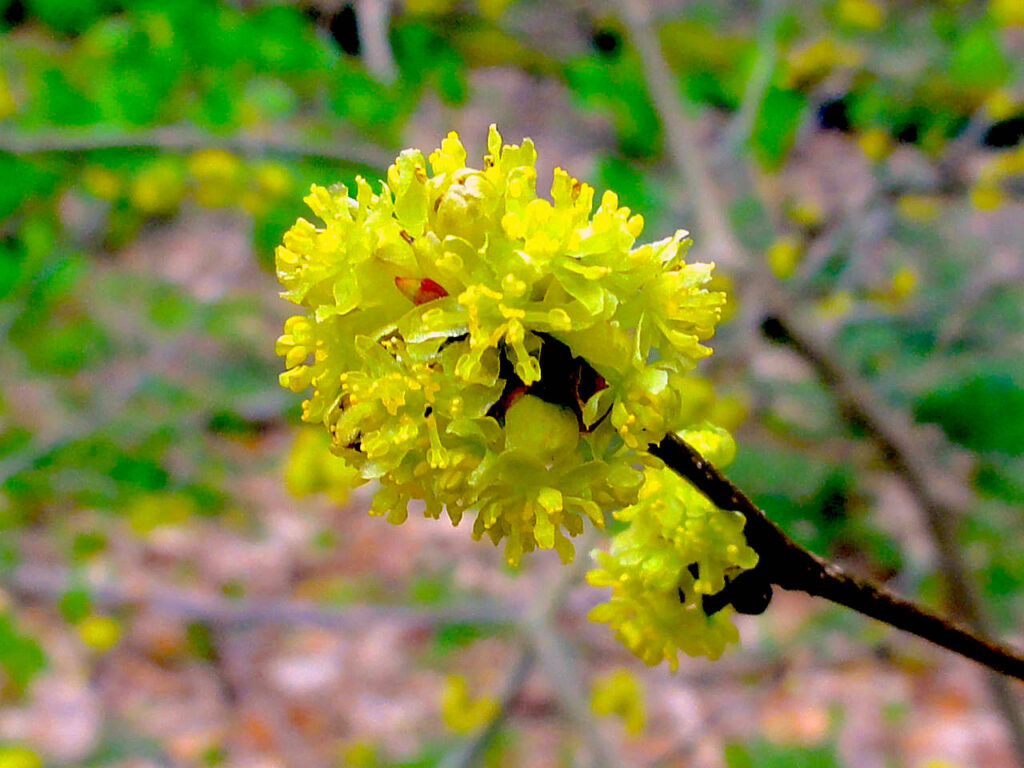
By Meg Muckenhoupt
May is the peak of spring migration season in Massachusetts, and thousands of birds are landing in Belmont. (You can even get radar reports on which birds are arriving overnight on birdcast.info.) But what will these birds do when they get here? Will they find the resources they need to survive, raise young, and embark on fall migrations next September? The answer may depend on what’s growing around Belmont—and a lot of what’s growing around Belmont is invasive plants.
Plants change birds’ lives
North American birds evolved with native plants. Most bird-lovers know that different types of birds prefer seeds: cardinals love black oil sunflower seeds, while finches prefer thistle seeds. However, birds’ relationships with plants extend far beyond seeds. Birds use plants for:
- Locating nests and providing nest-building materials
- Feeding their young caterpillars and insects
- Consuming fruit and flower nectar
Invasive nonnative plants can disrupt all of these functions by replacing the plants that birds used in the past. Fewer birds survive, and the birds that do survive raise fewer young and are less likely to survive fall and spring migration.
Nesting problems
Invasive plants often leaf out earlier than native plants, making them attractive places for returning birds looking for sheltered nesting spots. Unfortunately, this short-term advantage leads to long-term losses. Researchers found that when American robins nested in invasive Amur honeysuckle (Lonicera maackii) and common buckthorn (Rhamnus cathartica) bushes, their chicks were eaten by predators more often than chicks brought up in native viburnum or hawthorn shrubs. The nonnative shrubs were shorter than the natives, and their branch structures likely made it easier for predators to climb up to nests. Another study showed that northern cardinals and American robins nested five to six inches closer to the ground when they nested in nonnative honeysuckles and multiflora roses than when they made their homes in native shrubs.
Nonnative honeysuckles, common buckthorn, and multiflora roses are all widespread in Belmont’s open spaces and public lands.
Food for a marathon
Migration is a marathon for birds. When they stop to rest on their thousand-mile flights, they need plenty of food to fuel their journey. Unfortunately, the fruits on common invasive shrubs are the equivalent of a low-fat diet, depriving birds of the calories they need for a long, hard journey.
Researchers in Rochester, New York, analyzed the nutritional content of the fruits of invasive buckthorn, multiflora roses, bush honeysuckles, and European cranberrybush (Viburnum opulus) as well as the fruit of several native plants: gray dogwood (Cornus racemosa) silky dogwood (Cornus amomum), red osier dogwood (Cornus sericea), arrowwood viburnum (Viburnum dentatum), and spicebush (Lindera benzoin). The native fruits ranged from 6% to 49% fat. All the invasive fruits were less than 1% fat, and had far fewer calories per gram than the native fruits. Unsurprisingly, birds strongly preferred the highest-fat dogwood fruits to other foods.
A study of the feces of fall-migrating birds in Plymouth, Massachusetts, also showed that birds strongly preferred native plants, even though nonnative plants like Asian bittersweet, Japanese barberry, and multiflora rose have far more berries in the late fall. However, when native dogwoods are replaced by buckthorn and bush honeysuckle, birds can’t find their favorite fat-bombs to fuel their flights.
Food for growth
Invasive plants also affect birds that don’t even eat berries, the insect-eating birds, and most birds’ young. Most insects in the United States only eat species they evolved with because their ancestors developed ways of coping with the various chemical defenses the plants use to keep insects away. A spicebush swallowtail butterfly caterpillar can thrive on spicebush leaves, but it can’t digest hostas or burning bush; those species are toxic to them.
A University of Delaware study showed that areas dominated by nonnative plants including bush honeysuckles, Asiatic bittersweet, and Japanese knotweed had 91% fewer caterpillars than areas dominated by native plants such as arrowwood viburnum. This is terrible news for birds that eat insects, like Carolina chickadees, which may take up to 6,000 caterpillars to raise a brood of five young. The more non-native plants in a yard, the less likely chickadees were to nest and breed—and the ones that did breed had fewer surviving young than birds in native-dominated yards. According to researcher Douglas Tallamy, 96% of all terrestrial birds rely on insects for food for their young, if they’re fruit-eaters, or throughout their lives if they’re insectivores.
Changing the balance
Of course, not all birds are unhappy about having more nonnative honeysuckle around; plenty of birds are eating the nonnative fruits and spreading it through their droppings. In central Pennsylvania, the population of fruit-eating robins and catbirds has tripled in the past 30 years, despite the problematic nesting conditions. That may sound wonderful—more birds!—but in Massachusetts, those robins serve as hosts for eastern equine encephalitis (EEE). Robins overwintering in the wetland forests of southeastern Massachusetts serve as a reservoir for EEE. The more the bird population tips to robins, as they replace other birds, the more likely it is each summer that mosquitoes will spread EEE from robins to mammals to people.
This pattern seems to happen over and over; invasive nonnative plants benefit some species, but the overall diversity of species declines, and birds that were already in trouble have even more difficulty surviving. A 1999 study of tidal marshes in Connecticut found that invasive Phragmites reeds were preferred habitat for red-winged blackbirds, but there were significantly fewer species and rare species in marshes where Phragmites dominated over native marsh grasses.
Sometimes, invasive plants have effects on birds that are just puzzling. When cedar waxwings eat berries from invasive Morrow’s honeysuckle, their tails turn orange. And when invasive spotted knapweed plants in Montana crowd out food plants for chipping sparrows, the number of types of songs the chipping sparrows sang declined by 20% because young chipping sparrows didn’t have enough adults to learn all their songs from.
How to help birds
If you’d like to hear more birdsong in your yard, plant native plants. The National Wildlife Federation, Douglas Tallamy’s Homegrown National Park, and the Framingham-based Native Plant Trust all have plant finders you can use to find native plants that will thrive in your yard.
Since most birds eat caterpillars and insects at some point in their lives, supporting insects means supporting birds. You can find out which plants support local butterflies and moths at the National Wildlife Federation’s butterflies and moths finder. Belmont also has a great resource in the Mystic Charles Pollinator Pathways Group, which has plenty of local resources including a map of where to see pollinator-friendly gardens (online at tiny.cc/MCmap) and a Facebook group for asking questions.
Meg Muckenhoupt is editor of the Belmont Citizens Forum Newsletter.



Sorry, the comment form is closed at this time.